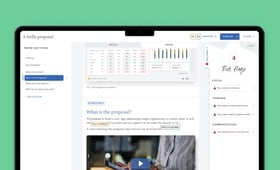Every organisation needs an effective board of directors — one that successfully taps into its members’ collective experience, skills, and perspectives. Without it, organisational performance and resilience suffer.
An effective board isn’t easy to achieve, however. Our latest Board Value Index found that almost half of directors in the US and UK believe their board isn’t adding enough value.
So, how can you manage a board more effectively? This guide explores how to manage a board of directors and the tools that can help improve board effectiveness.
Why effective board management matters
Good board management underpins the board’s ability to govern — providing strategic clarity, managing risk, providing oversight, and delivering long-term success.
As Pippa Begg, CEO of Board Intelligence, said on the launch of the Board Value Index: “In a world of volatility and rapid change, valuable boards do more than oversee. They challenge inertia, cut through the noise, and ensure their organisation is future-focused.”
The impact of strong governance on business outcomes
Better boards build better businesses. McKinsey research on board effectiveness shows that directors who rate their boards highly for operational dynamics and governance processes are far more likely to report financial outperformance. Specifically:
- 59% of directors at top-quartile boards report that their organisation significantly outperformed peers, compared with only 43% at bottom-quartile boards.
- Nearly 60% of directors at top boards say their organisation outperformed peers on strategy, versus 32% at bottom-tier boards.
The activities that most support outperformance are all strategy-related — assessing value drivers, setting a clear framework, and evaluating strategic options with management.
In addition, research by Deloitte found that well-run boards are more agile and effective in fast-moving environments, particularly when they combine foresight with disciplined oversight. Boards that are managed effectively are better able to respond to change, uncertainty, and volatility — all of which are common pain points in modern boardrooms.
Risks of poor board oversight
Boards that are not managed effectively expose their organisations to avoidable risks — from strategic drift to governance failure.
- Strategic drift. When boards fail to challenge or refresh strategy, organisations lose focus and agility. Competitors adapt faster, while the board remains stuck debating outdated plans.
- Weak risk oversight. Risk registers that exist only on paper leave boards blind to emerging threats. The collapse of several UK construction firms shows how insufficient scrutiny of cash flow and supplier risk can lead to sudden failure.
- Slow decisions. Poorly structured meetings and overloaded papers delay critical choices. Boards that hesitated to adapt during COVID-19 were overtaken by those that made quicker, evidence-led calls.
- Reputational damage. Oversight gaps on ESG or compliance can quickly escalate. Governance failures at firms like Wirecard and Carillion show how weak challenge erodes trust and invites regulatory action.
Poor oversight undermines value, confidence, and credibility. Effective management ensures directors have the clarity, information, and structure to provide rigorous oversight and make sound, timely decisions.
Key challenges in managing a board
Effective board management doesn’t happen by accident — it depends on how the board is supported and equipped to do its job. Even experienced boards face obstacles that limit their effectiveness – from poor alignment to a lack of engagement.
Misalignment between board and management
When the board and executive team are out of sync, the result is blurred accountability and confused priorities. Board Intelligence’s State of Board Effectiveness research found that 74% of directors say their board doesn’t spend enough time on the organisation’s big picture vision and goals.
In our experience, this is often caused by three things:
- A lack of clarity around the board’s mandate — what the board’s priorities are, what it’s responsible for (and not), and what success looks like.
- Overcrowded, backward-looking agendas that follow a routine formula rather than aligning the board’s time with organisational priorities. Boards end up debating what’s already happened instead of shaping what happens next.
- Board packs overloaded with operational detail, lacking context and actionable insights. This limits the board’s ability to provide oversight and make timely, well-informed decisions.
Together, these challenges result in boards that over-index on their supervisory role at the expense of their steering role and directors who feel underprepared to respond to emerging risks and add strategic value.
Poor board culture and dynamics
Board culture significantly impacts governance effectiveness, yet fostering a healthy culture can be a challenge. Many boards struggle with a lack of psychological safety, entrenched hierarchies, or dominant personalities, which can suppress diverse viewpoints and hinder open debate.
Research shows that boards with high psychological safety are more inclusive, creative, and resilient, and that recognising and mitigating power imbalances is essential for fostering trust and constructive challenge.
Succession planning
Succession planning is a common challenge for boards; our analysis of FTSE 100 board evaluation disclosures found that succession planning was one of the most frequently reported development areas identified in board reviews. Many boards struggle to maintain leadership continuity at both the executive and board levels, leaving organisations exposed during transitions and times of crisis.
Without structured planning, boards risk gaps in capability, weaker oversight, and slower strategic decision-making. Renewal is essential to maintain the right mix of skills, experience, and perspectives.
Meeting regulatory responsibilities
Boards face growing complexity in legal and regulatory oversight and failing to keep pace is a common challenge. Directors must navigate evolving requirements across corporate governance, financial reporting, cybersecurity, and ESG obligations, while ensuring compliance with fiduciary duties.
Strong, proactive regulatory governance protects the organisation and enables directors to focus on strategic decision-making rather than reactive problem-solving. However, boards that struggle to monitor regulatory changes or embed robust compliance frameworks risk legal breaches, reputational damage, and weakened stakeholder confidence.
Lack of engagement and preparedness
Low engagement from directors can be structural. Directors are more likely to disengage, and not prepare sufficiently, if meetings are dominated by reporting rather than debate, or directors don’t feel empowered to challenge or aligned with the organisation’s purpose, for example.
Engagement can also be impacted by poor board processes which make it hard for directors to prepare effectively for meetings — for example, when board materials stretch to hundreds of pages and arrive too late for thoughtful review.
Improving board communication and decision-making
Better inputs lead to better conversations and outcomes, and that begins with how you communicate.
Best practices for board reporting
Good reporting is the foundation of an effective board. Board Intelligence’s board reporting methodology, the Question-Driven Insight (QDI) Principle, is based on our work reviewing and transforming thousands of board packs over nearly two decades. This methodology ensures board materials are:
- Stacked with critical thinking: by asking better questions, we uncover sharper insights and breakthrough ideas
- Clear, concise, and compelling: great communication turns those insights into action
- Focused on what matters most: when we are focused and aligned, we drive meaningful progress
You can visit our board and management papers hub to learn more about best practice board reporting and find some helpful tips in our guide to building effective board packs.
Using AI tools to enhance board communication
Focused, impactful board discussions are built on clear thinking — exactly what Report Writer, our AI-powered writing assistant, and Insight Driver, our board meeting insight assistant, were designed to support.
Find out more in our AI for board performance hub and read our guide to how high-performing directors are using AI to prepare for board meetings for more advice.
Using data and KPIs for smarter decisions
Without structured metrics, it can be difficult for directors to assess and understand performance or spot emerging risks and opportunities.
Effective boards use KPI dashboards to monitor critical areas such as strategic objectives, risk exposure, director engagement, and decision timeliness. Data from past meetings, action completion rates, and board pack usage can highlight inefficiencies or gaps in oversight. When combined with qualitative insights, such analytics enable directors to make evidence-based decisions rather than relying solely on intuition.
With Insight Driver, see what matters in your board materials, spot gaps in data or reasoning, and use AI to generate value rather than abstracts.
See Insight driverBest practices for running an effective board meeting
Efficient and effective board meetings require thoughtful orchestration, from clear agendas to timely follow‑up. Here are some cornerstone practices that make every moment in the boardroom count. Read our guide to running an effective board meeting for more.
Setting agendas and managing time
Boards typically dedicate just 32% of their meeting time to strategic discussions, while 41% is spent reviewing performance and 26% on governance matters. Yet, 44% of the board members we surveyed said they wish they had more time to focus on strategy.
Taking a strategic approach to agenda planning can shift this balance and help boards dedicate their limited time to strategic conversations instead of tactical nitty-gritty. Start by mapping out the big picture priorities for your board and building your annual calendar around them. Then, in individual meeting agendas, put those big picture items and critical discussion topics at the top of the agenda and add everything else in after them – for example, the routine performance updates. Consent agendas can be used to make this easier.
Tools like Agenda Planner, available within the Board Intelligence board portal, help streamline the process of analysing where your board spends its time, building forward agendas, and responding to last-minute changes. This way, the most important topics are discussed at the right time and in the right forum.
Chairing the meeting
The chair of the board plays a pivotal role in ensuring board meetings are productive and strategically focused. Many boards struggle when chairs are either too passive — allowing discussion to drift — or too controlling, stifling debate and diverse perspectives.
Effective chairs guide discussion, prioritise strategic topics, and manage time efficiently. They create an environment where directors feel confident to challenge management and each other, fostering rigorous debate without conflict. Chairs also monitor engagement, ensuring that dominant personalities do not overshadow quieter voices, and intervene when discussion becomes unproductive.
Digital tools can support chairs in this role. Analytics within agenda planning software allow chairs to track how meeting time is spent, highlight under-discussed strategic priorities, and adjust future agendas accordingly. By combining strong facilitation skills with digital insight, chairs can ensure meetings are efficient, inclusive, and focused on outcomes that drive organisational performance.
Capturing and following up on actions
To be productive, a meeting must lead to clear, actionable outcomes. Effective boards capture decisions and follow up with precision:
- Create concise, structured meeting minutes that record resolutions, decisions, and relevant context without transcribing verbatim.
- Present action items clearly, specifying owners, deadlines, and next steps.
- Distribute draft minutes promptly for confirmation and alignment, ensuring all directors understand decisions and responsibilities.
- Judge minutes by accessibility, so a new director can understand both the decision and the rationale behind it.
Digital tools and AI can make this process faster, more accurate, and easier to track. Board Intelligence’s Minute Writer uses AI to convert notes and transcripts into structured, actionable minutes automatically. It highlights key decisions, assigns actions to owners, and integrates deadlines, reducing administrative burden and ensuring accountability. When paired with a secure digital board portal, directors can review, comment on, and confirm minutes efficiently, keeping everyone aligned and enabling the board to focus on strategy rather than paperwork.
Building a high-performing board
Strong boards don’t happen by accident, they’re designed. The process starts with assembling the right people around the table, but it doesn’t stop there.
Board composition and diversity
A high-performing board reflects the organisation’s strategic needs. Research from Harvard Law on cognitive diversity and AllianceBernstein shows that diverse boards make better decisions and achieve stronger outcomes. McKinsey’s diversity study also found that gender-diverse boards are 27% more likely to outperform financially.
Board evaluations and ongoing director development
Regular board evaluations create space for reflection and opportunities for continuous improvement. Board Intelligence’s methodology for board performance reviews is based on the “5 I’s of board effectiveness”: Individuals, Information, Infrastructure, Impact, and Innovation.
It’s essential that board reviews lead to actionable insights. High-performing boards are selective in how they approach upskilling and are increasingly focused on embedding a culture of continuous improvement to improve board effectiveness.
Pro-tip: Use the board effectiveness checklist to quickly identify what your board is doing well and where there might be room for improvement.
Crisis management and forward-looking oversight
Boards must be prepared for crises that can affect financial stability, operations, reputation, and regulatory standing. Effective boards anticipate potential scenarios, assess vulnerabilities, and ensure management has contingency plans in place. They meet regularly to review risk registers, stress-test strategies, and maintain oversight of critical areas such as cybersecurity, supply chain resilience, and regulatory compliance.
Tools to manage your board more effectively
Modern board management combines digital solutions with structured processes. Board management software helps directors access papers, collaborate securely, and track actions. AI-enabled tools support smarter reporting and insight generation, while evaluation and survey tools provide structured feedback to strengthen governance practices.
Board management software
Board portals provide a secure, centralised environment for board papers, meeting schedules, and communications and are integral to effective board management. Features such as agenda planning and note-sharing ensure meetings are focused and productive, and AI-powered tools like Minute Writer streamline the creation of structured, actionable meeting minutes.
By combining security, functionality, and insight, board management software improves efficiency and governance quality.
AI tools for board governance
AI offers significant opportunities to augment board effectiveness. Tools like Insight Driver can summarise board packs, highlight key insights, and prompt directors to challenge constructively, while tools like Report Writer support management to deliver high-quality briefing materials. Read our definitive guide to AI in the board pack and explore our AI for board performance hub for more detail.
Tools for continuous improvement
Boards should regularly evaluate their own performance and identify areas for development. Board Intelligence’s Board Surveys tool allows directors to provide structured feedback on everything from meeting quality to strategic impact. Combined with facilitated reviews, these insights inform board and director upskilling plans and ensure governance evolves with the organisation’s needs.
Supporting directors’ preparation for board meetings
Preparation is key to effective decision-making. To do it well, directors need to review materials efficiently, focus on critical issues, and come ready to contribute. Tools like Insight Driver summarise complex papers, highlight questions for debate, and help directors prioritise attention. Coupled with our director meeting preparation checklist, these tools make it easier for directors to engage meaningfully and for the board to maximise the value of every meeting.
Conclusion: effective by design
Boards that set themselves up to succeed are more likely to steer organisations through complexity and change.
Managing a board effectively requires a combination of strategy, structure, culture, and tools — as well as a sustained focus on what matters and a commitment to continuous improvement. Board Intelligence provides methodologies, tools, and services to help boards put these best practices into action and unlock lasting organisational value.
With the “easiest to use board portal on the market”, powered by enterprise-grade security, first-rate support, and features that set your board and governance team up to succeed.
Book a demonstrationFAQs
-
What qualifications should a board director have?
Strong strategic, financial, and governance skills, with expertise in risk, digital transformation, or ESG, are increasingly sought after. Refer to the Institute of Directors’ guidance on board composition for a full overview and explore Board Intelligence’s board development solutions to fill skills or knowledge gaps.
-
How often should a board of directors meet?
Most boards meet quarterly, though top-performing boards schedule additional sessions for strategy and risk oversight.
-
What’s the difference between board oversight and management?
Board oversight ensures the organisation stays well-governed and on track. Management handles execution.
-
How can boards measure their own performance?
Board performance should be measured both qualitatively and quantitatively, via surveys, KPI dashboards, structured board evaluations, and peer feedback. Assessing board performance at regular intervals means boards can track their performance over time and make targeted interventions to improve their impact.
-
How should boards handle succession planning and talent strategy?
Boards should take a structured approach to succession and talent development. This includes reviewing executive and board talent pipelines and regularly evaluating board and executive team composition, mapping it against future needs. Ongoing education programs equip directors to respond effectively to evolving strategic, regulatory, and technological challenges.
Can't find what you're looking for? Our friendly team are on hand to help.
Talk to our team


